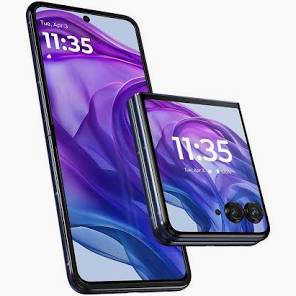Moto Razr+ 2024 - YES?? - UPDATED
- Bryan Steenerson

- Apr 5
- 3 min read
Updated: Apr 6
I first wrote that this phone was ok on the eyes because I didn't understand the readings for the lower brightness levels. After much more testing I came to the conclusion that the readings are accurate, which actually shows that this phone isn't too great for the eyes. I will make updates below to better reflect. Original Review below: (updated April 6, 2025)
I really love this phone. It's small when you want it too, it's big when you need it to be, and it's most of all FUN! For this test I only tested the interior display as that is the primary one most people will be using, however I did find that you can do almost everything you need to on the small outer display without even opening up the device, which is absolutely amazing. The Razr+ is an interesting device when it comes to flicker as it has a setting called "flicker prevention" which reduced flicker. I tested both with flicker on and with it off.
For your convenience I am putting the comparisons beside each other. At about 100% you can see there is about a 10% difference in modulation, obviously with flicker prevention on it is decent. However we see that the frequency is fairly low which may bother some people. In my research I have found that people are more impacted by modulation than they are by frequency so at this low modulation it might be ok for you, however the frequency rate is really low which isn't necessarily good.
Around 50% brightness we see that it's almost the same for both, no change if the flicker prevention is on or off, which is interesting. Still this is probably ok for most people, but maybe not for those sensitive, as the modulation is decent around 48% but the flicker rate is still very low at 184hz.
I originally wrote that this was ok, and I'll leave my original thoughts below for transperancy. In both cases we get a very high modulation. With flicker prevention off the hertz is higher at 737hz frequency, but the modulation is also high at 99.5%. This is better than apple, but still not great for the eyes. With flicker prevention on, it attempts to do some DC dimming. But after an hour of testing that I did with my opple reader I came to the conclusion that it still flickers at the rate read at 184hz with a high modulation rate of 91.2%. If you look at the chart on the right, you still see the dips to zero, and this is what the eyes are going to pick up on, even though it looks like dc dimming in between. This will still affect the eyes and not be very good for those impacted by PWM. I can't really recommend this device.
ORIGINAL REVIEW:
Here is where it gets interesting. In general if flicker prevention is off somewhere between 35% and 50% it switches to a high frequency of 737hz (almost double samsung and iphones). But the modulation is bad at 99.5%. If the flicker prevention is on we get an odd reading. The modulation depth says 91.2%, but if you look at the wave on the far right, it's not the whole story. From what I can tell it seems that it is in a DC dimming mode with a very high frequency rate and low modulation with the oppo light meter picking up the refresh rate. I tested this multiple times and each time got the same reading. Overall I would say this is probably safe, but might need some more testing for this device. If it is not DC dimming than I would say leave the device in normal mode as that would be better in low light instances.































Comments